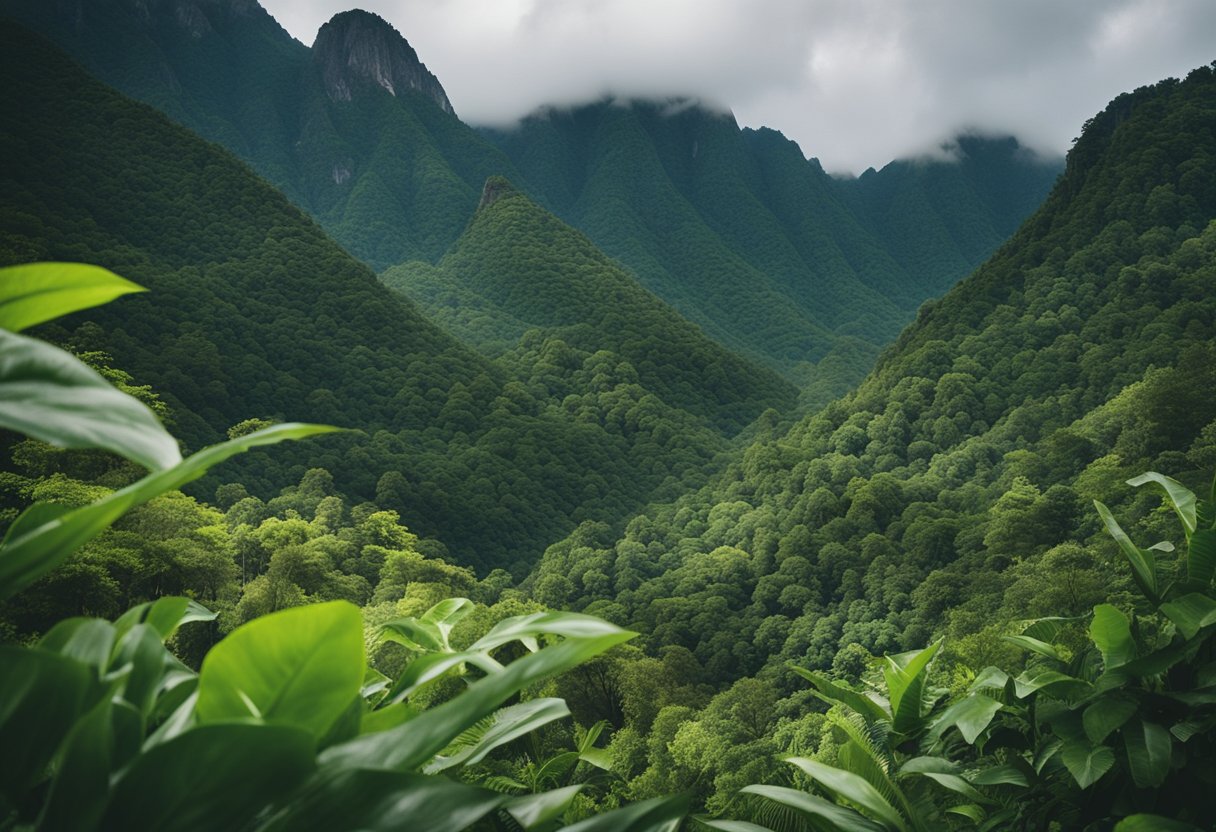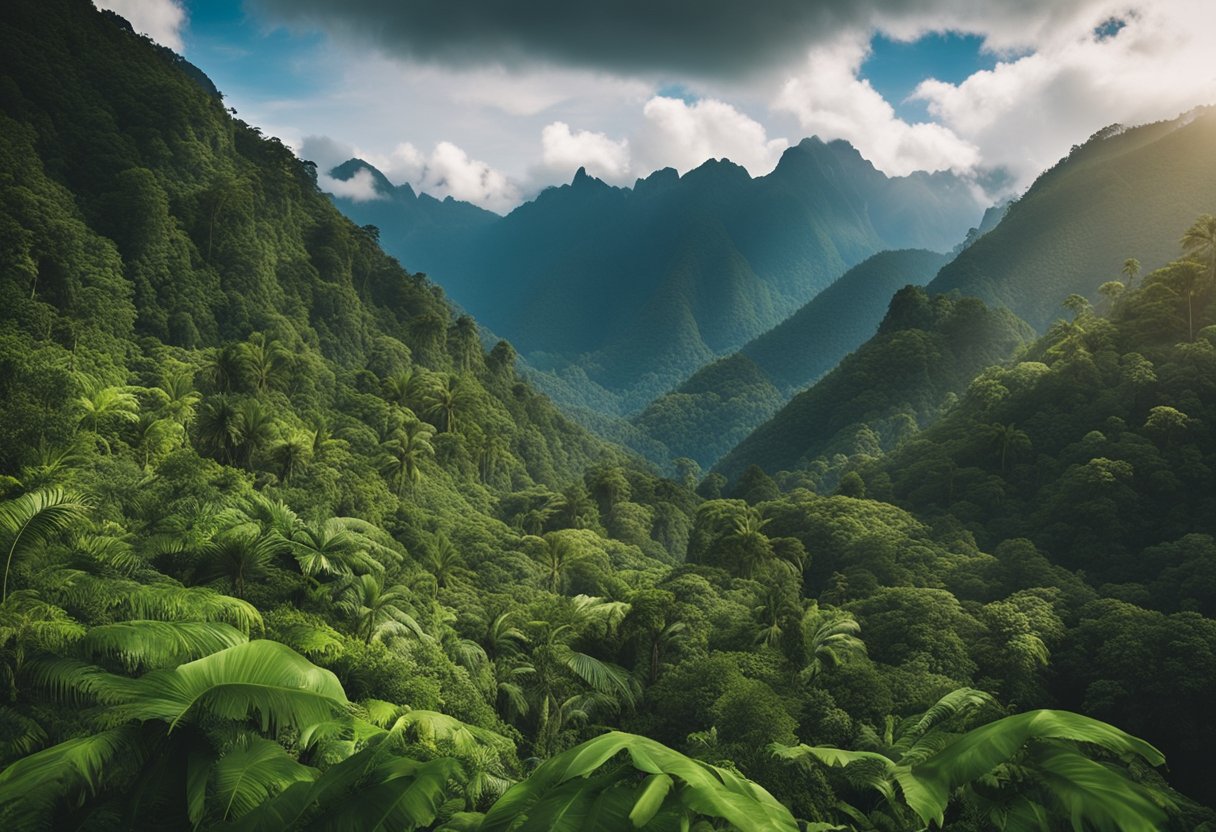The Tradition of Herbal Medicine from the Amazon to the Alps: A Comparative Study

Updated On: April 15, 2024 by Raghda Elsabbagh
Across the world, from the lush Amazon Rainforest to the snow-capped Alps, herbal medicine traditions form a bridge between the past and present, connecting us to the ancestral wisdom of diverse cultures. These practices are not relics of a bygone era but living systems of knowledge that continue to evolve and contribute to healthcare. The Amazonian basin, home to an unparalleled biodiversity, has nurtured a pharmacopoeia of plant-based remedies, passed down through generations and steeped in the deep spiritual relationship between indigenous communities and their environment.

In Europe, the Alps hold their own centuries-old legacy of botanical healings, where monks and local herbalists harnessed the alpine flora for its curative properties. These traditions, influenced by Galenic and Celtic medicine, have persisted and adapted through the ages. Today, they coexist with modern medical practices, offering complementary and alternative therapeutic options that are the subject of both research and renewed interest. Our exploration of these herbal traditions sheds light on a significant facet of our history and culture while highlighting the ongoing relevance and potential of traditional medicine in contemporary medical practice.
Table of Contents
Historical Contours of Herbal Medicine
In this section, we explore the rich tapestry of herbal medicine that has shaped human well-being across various continents and cultures throughout history.
Global Herbal Traditions
From the depths of the Amazon rainforest to the high peaks of the Alps, herbal traditions have formed an integral part of human natural history. Tribes in the Amazon have long utilised the materia medica provided by the lush biodiversity around them, where every plant seemed to hold medicinal value. Similarly, the Celts had their own herbal knowledge, relying on the flora of their lands to heal and sustain.
Across the globe, from ancient Greece to India, medicinal plants provided the cornerstone of health care. Hippocrates and Galen are prime examples of figures who documented their uses in Greek medical texts, thus influencing subsequent Roman and Arab physicians. These traditions not only offered remedies for physical ailments but were often deeply entwined with cultural identity and oral tradition passed down from one generation to the next.
Emphasising the vitality of these plant-based treatments, Indian Ayurvedic medicine has stood the test of time, remaining influential to this day. This deep-seated knowledge underscores the value of herbal medicine not just as a historical curiosity but as a living, breathing aspect of cultural heritage.
Cultural and Medical Integration
Herbal medicine has not remained static; it has continuously integrated into various cultural contexts. Roman healthcare practices assimilated Greek and indigenous knowledge, thus paving the way for future medical understanding across Europe. Arab scholars further contributed by translating and expanding upon the Greco-Roman texts, thereby preserving and enhancing the collective medicinal knowledge.
In our present times, this integration is evident as herbal medicine experiences a renaissance on platforms like PubMed, with a growing recognition of the contribution of traditional remedies to modern medicine. It is crucial to respect these practices within their cultural contexts, acknowledging the value they have held for tribal groups and children who are often the first to learn from their elders and for whom these practices form part of their identity and well-being.
By understanding the historical contours of herbal medicine, we affirm our commitment to preserving this knowledge. Just as we at Connolly Cove cherish the richness of cultural heritage from the Amazon to the Alps, we recognise the importance of maintaining the integrity and diversity of these ancient healing arts.
Understanding Herbal Medicine
In this section, we explore the intricate relationship between humans and plants and weigh the contrasts between herbal and modern medicine.
Foundations in Nature
The lore of herbal medicine is deeply rooted in the biodiversity of our planet. It’s based on the use of medicinal plants, which have served to treat various disorders for millennia. Our understanding of these natural remedies is supported by traditional knowledge that has been handed down through generations. It is also increasingly supported by scientific research aiming to validate and understand the mechanisms behind plant-based treatments.
- Medicinal Plants: They are often the basis for modern drugs, with a significant percentage of pharmaceuticals being derived directly or indirectly from them.
Herbal Medicine vs Modern Healthcare
When we examine herbal medicine vis-à-vis modern healthcare, several key differences emerge. While modern healthcare often focuses on symptom management and the treatment of disease, often using synthetic drugs, herbal medicine emphasises holistic wellness, with treatments aimed at addressing the root causes of disease. Herbal remedies are sometimes perceived to have lower mortality rates associated with their use, particularly in remote areas where modern healthcare is inaccessible. However, it’s essential to approach this comparison with an understanding that both systems have their merits and contexts where they are more applicable.
- Conservation: The sustainable use of plants is paramount to ensure that this rich resource is available for future generations. It intersects with global efforts in nature conservation and ethical healthcare practices.
In embracing the traditions of herbal medicine, whether from the rich greenery of the Amazon or the alpine meadows of the Alps, we adopt an approach to health that is inextricably linked to the natural world and its preservation.
Ethnobotany and Herbal Knowledge
In this section, we explore the rich tapestry of herbal medicine, tracing the lineage of plant-based healing from the depths of the Amazon rainforest to the heart of the Alps. Ethnobotany, a term intertwined with herbal knowledge, is the scientific study of the relationships that exist between people and plants.
Ethnobotanical Studies
Ethnobotanical studies carefully document the indigenous use of plants, particularly for medicinal purposes. By examining practices from the Amazon, where the term “Ethnobotany” was first coined, to the traditional uses of officinalis species in the Alps, researchers compile a compendium of knowledge that is crucial for the future of natural medicine. Scholarly databases such as Google Scholar, Scopus, and JSTOR provide extensive literature on the subject, making historical and contemporary findings accessible.
- Key Research Repositories:
- NCBI (National Center for Biotechnology Information)
- Google Scholar
- Scopus
- JSTOR
Transmission of Knowledge
The transmission of ethnobotanical knowledge typically occurs through oral tradition and is an integral part of folk medicine. Generations of healers, from the shamans of South America to the herbalists in Alpine regions, have passed down their understanding through stories, practices, and written texts such as herbal encyclopedias. Today, with the convergence of traditional and scientific realms, this herbal knowledge is being meticulously preserved and continues to be a cornerstone for both pharmaceutical research and alternative therapies.
- Transmission Modes:
- Oral tradition
- Written texts
- Digital databases
By honouring these practices and sharing our findings, we play our part in safeguarding this invaluable knowledge for future generations.
Bioactivity and Ethnomedicine
Our exploration of traditional herbal medicine reveals a deep-seated knowledge of the bioactive properties of plants used by indigenous cultures across the globe. These ethnomedicinal practices are rooted in a rich history and have been passed down through generations, proving to be invaluable for treating a multitude of disorders.
Role in Treating Disorders
Medicinal plants from the Amazon rainforest to the European Alps have been utilised in medical practice to treat a myriad of disorders. These plants often contain compounds that exhibit anti-inflammatory properties, helping to alleviate symptoms in a range of ailments. Within traditional communities, knowledge of specific herbs and their curative abilities is of immense importance.
Evidence-based Herbal Remedies
The efficacy of these herbal remedies is increasingly supported by scientific research, with studies indexed on platforms like PubMed and Scopus substantiating their bioactivity. Numerous herbal remedies once grounded in anecdotal evidence are now gaining recognition within the broader scientific and medical communities for their potential in formal medical practice.
Cultural Significance of Herbal Healing

Herbal healing has been woven into the fabric of many societies, forging a link between nature and cultural identity. It is an integral component of folk medicine, traditionally passed on through generations.
Herbal Medicine in Daily Life
In the verdant Amazonian region, the use of herbs is not just about treating ailments; it’s a cultural cornerstone. Here, families grow up with knowledge passed down by herbalists who lean on plants like tobacco and ayahuasca for both physical and spiritual wellness, reflecting an enduring cultural identity. For instance, the deep-rooted wisdom within the Amazon is preserved by indigenous cultures, with certain plants integral to daily life and rituals. The indigenous people’s practices are a testament to the rich history of traditional medicine in this lush domain.
Conversely, in the Alps, herbal medicine knits into the fabric of alpine life. It’s not uncommon to find families using locally sourced herbs to create remedies, echoing the cultural significance that has been nurtured over centuries. Alpine folk medicine incorporates a variety of plants for health, reflecting age-old traditions upheld in contemporary households.
Children in these areas grow up learning the significance of local flora. This early education in traditional medicine supports the transmission of folk wisdom and nurtures a bond with nature that lasts a lifetime. It is a form of heritage conservation, keeping alive practices that might otherwise succumb to modern medical approaches.
Through teaching the next generation and maintaining these practices, communities cherish their heritage, ensuring that the wisdom of the elders and the natural environment sustain their way of living, now and into the future.
Regional Herbal Practices
Prior to delving into specifics, it’s pertinent to acknowledge the profound impact regional practices have had on the discipline of herbal medicine. Each region offers a unique lens through which we observe the integration of natural remedies within cultural spheres.
Amazonian Ethnomedicine
The Amazon is lauded for its vast biodiversity, serving as a repository for an array of medicinal plants. Tribal groups within the Amazon have honed their expertise over millennia, cultivating deep-rooted connections with the surrounding flora. They possess vast knowledge about the therapeutic applications of plants, which is often encapsulated in traditional texts or oral traditions. A distinct illustration of this knowledge is the creation of a comprehensive traditional medicine encyclopedia by the Matsés people, encompassing 500 pages of medicinal wisdom.
- Self-heal (Prunella vulgaris): Often utilised for its anti-inflammatory properties.
- Valerian (Valeriana officinalis): Traditionally used by tribes as a sedative and for treating disturbances in sleep.
Tribal groups in the Amazon, including the Matsés, have been the custodians of this treasure trove of ethnomedical knowledge, actively employing plants for healing and spiritual purposes.
Herbal Medicine in the Alps
Contrasting the tropical abundance of the Amazon, the Alps stand majestically across Central Europe, boasting a different yet equally rich tradition of herbal medicine influenced by various European cultural groups, including those from the Balkans and Eastern Europe. In these regions, the practice of using medicinal plants is woven into the fabric of daily life and often passed down through generations.
- Valerian (Valeriana officinalis): Also found in Alpine regions, it’s primarily used to ease insomnia and anxiety.
- Self-heal (Prunella vulgaris): Commonly found across Europe, including the Alpine regions, its usage mirrors that in the Amazon.
Our exploration into these distinct ecosystems showcases a mutual reliance on Valerian and Self-heal as medicinal staples despite geographical and cultural disparities.
Ecological Perspective on Medicinal Plants

In exploring the intricate connection between ecology and herbal remedies, we must highlight the crucial roles of biodiversity and conservation in sustaining the wealth of medicinal plant knowledge.
Conservation and Biodiversity
The Amazon rainforest, often described as the Earth’s lungs, serves as an immense repository for medicinal plants whose potential has been shaped by centuries of indigenous wisdom. Local medical systems flourish thanks to this diversity of plant species, which are deeply embedded in the cultural knowledge of indigenous peoples. For instance, the indigenous Amazonian traditional medicine utilises the tobacco plant in complex healing rituals overseen by skilled healers, as evidenced by a case study conducted in the Peruvian Amazon.
The Amazon is not the only region with a rich tapestry of medicinal plant use; the Alps also harbour unique flora with a substantial catalogue of bioactive compounds. However, the sustainability of these natural pharmacies hinges on effective conservation strategies. Over-harvesting and environmental degradation pose significant threats to both the Amazon and Alpine biodiverse landscapes.
Global climate challenges threaten our collective medicinal plant knowledge and its ecological foundations. As such, understanding the nature of plants’ medicinal properties requires us not only to document their bioactivity but also to engage in conservation efforts that ensure these plants’ long-term viability. A body of work, including a comprehensive review featured in The Lancet, suggests an urgent need to evaluate natural medicinal resources within the context of their exposure to global environmental changes.
In conclusion, it is imperative for us to protect the delicate balance of these ecosystems, ensuring the perpetuity of traditional medicinal knowledge and the biodiverse nature that sustains it.
Herbal Traditions of the European Celts

Before we explore the intricacies of herbal traditions amongst the European Celts, it’s essential to understand their profound connection to nature and the intricate link between their language, culture, and healing practices.
Celtic Ethnopharmacology
The Iron Age Celtic peoples, spanning regions from the Hallstatt to the British Isles, possessed extensive knowledge of plant-based remedies. Our ancestors, the Insular Celts, developed a system of medicine that was predominantly influenced by their natural environment. Commonly found plants in these regions played vital roles in their ethnopharmacology, where herbs were not only used for healing but also carried symbolic significance. For instance, the use of plants in Celtic medicine was deeply rooted in both physical and spiritual healing processes, reflecting a holistic approach to health and well-being.
Examples of Celtic Medicinal Plants:
- Foxglove (Digitalis purpurea): Presumed to treat heart conditions
- Self-heal (Prunella vulgaris): Used for wound healing
Celtic healers, or “druids,” were considered guardians of this herbal knowledge, which they are believed to have passed down through generations orally. Their understanding of local flora was likely unparalleled, and their practices were influenced by both Gallic and Celtiberian traditions.
Linguistic and Cultural Connections
The Proto-Indo-European linguistic community is key to understanding Celtic herbal medicine’s historical context. As their language spread, so too did their culture and ethnopharmacological practices. The linguistic community of the Celts encompassed two primary branches: Goidelic and Brittonic. The former gave rise to the languages spoken in Ireland and Scotland, while the latter developed in what is now Wales, Cornwall, and Brittany.
Our heritage reveals that within this cultural tapestry, language and medicine were deeply intertwined, with a united belief system and a shared botanical vocabulary that reflected the rich biodiversity of their lands. The Celts, with their sophisticated knowledge of plant properties and their uses, contributed significantly to the wider European phytotherapy and left a lasting imprint on traditional European medical practices.
Influences of Classical and Foreign Traditions
Herbal medicine’s richness is in part due to its absorption of practices from various cultures, notably the Greco-Roman tradition. The classical texts and the extensive ‘materia medica’ are pivotal to understanding these longstanding influences.
Greco-Roman Contributions
The Greco-Roman period made significant contributions to the field of traditional medicine. Greek and Roman societies developed an extensive ‘materia medica’, gathering medical knowledge from across the known world. Pedanius Dioscorides, a Greek physician in the Roman army, authored “De Materia Medica”—a tome that catalogued over 600 plants and their uses.
This encyclopedia of herbal knowledge became the standard reference for centuries in Europe and the Middle East, informing pharmacopoeias and herbalists alike. Through translations and adaptations, classical wisdom trickled down to local healing practices, blending with indigenous knowledge and adding layers to the complexity of herbal traditions extending from the Amazonian forests to the Alpine meadows.
Documentation and Research
Within the realm of herbal medicine, rigorous documentation and research are fundamental for understanding the efficacy and historical context of traditional practices. We can trace herbal traditions from the Amazon rainforests to the Alpine meadows through contemporary study sources, including archaeobotanical literature and databases such as PubMed, Google Scholar, JSTOR, and ScienceDirect.
Contemporary Study Sources
We draw upon a multitude of contemporary study sources to bolster our understanding of herbal medicine. Archaeobotanical literature sheds light on ancient practices, providing historical data that can be compared with modern applications. By consulting scientific journals and databases, we unearth peer-reviewed studies that propel the tradition of herbal medicine into the scope of current academic discourse.
- PubMed serves as a repository for biomedical literature, offering access to research that often includes the medical application of herbs.
- Google Scholar provides a broad sweep of scholarly articles across various disciplines, facilitating access to both current and historical perspectives.
- JSTOR archives an extensive collection of academic journals that encompass studies related to the ethnobotanical uses of plants.
- ScienceDirect is a leading source for scientific and medical research, with articles that often explore the pharmacological potential of herbal remedies.
By intertwining these sources with the rich narrative of herbal practices, we gain not only a deeper respect for the tradition but also a substantiated comprehension of its place in contemporary healthcare and education.
Frequently Asked Questions
In this section, we explore some of the most pressing queries pertaining to the rich traditions of herbal medicine that span from the dense greenery of the Amazon to the elevated meadows of the Alps. Our aim is to provide concise answers that enhance your understanding of these age-old practices, their influence on modern medicine, and some intriguing facts about their efficacy.
Which medicinal plants are native to the Amazon rainforest, and what are their uses?
The Amazon rainforest is home to a plethora of medicinal plants, such as the versatile Cat’s Claw, which is recognised for its immune-boosting properties, and the anti-inflammatory-rich Copaiba oil, derived from the sap of the Copaiba tree.
How have the traditions of herbal medicine from the Amazon influenced modern pharmacology?
Herbal medicine traditions from the Amazon have significantly shaped modern pharmacology, with many modern drugs being derived or inspired by compounds found in Amazonian plants. These plants have provided critical leads in drug development, particularly for treatments of diseases such as malaria and various cancers.
What are some surprising facts about the efficacy of herbal remedies sourced from rainforests?
It’s often surprising to learn that many herbal remedies from rainforests match and sometimes surpass the efficacy of conventional medicines, particularly in areas without access to modern healthcare. Additionally, these remedies typically have fewer side effects due to their natural composition.
In what ways have Alpine herbal medicine practices been preserved and utilised in contemporary health treatments?
Alpine herbal medicine traditions, such as the use of Arnica for bruising and muscle pains, have been preserved and utilised in contemporary treatments in the form of homoeopathic remedies, herbal teas, and topical applications in many European countries.
What percentage of current pharmaceuticals are derived from plants found in the Amazonian ecosystem?
It is estimated that around 25% of current pharmaceuticals have been derived from plants that originate in rainforests, with a notable portion of these coming from the vast biodiversity of the Amazonian ecosystem.
Which Amazonian herbs are most commonly sought after for their medicinal properties?
Amazonian herbs like Guarana, with their stimulating properties, and Camu Camu, known for their exceptionally high vitamin C content, are among the most commonly sought after for their potent medicinal properties.






